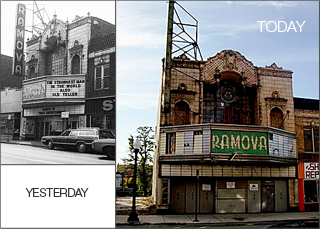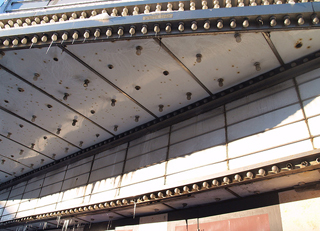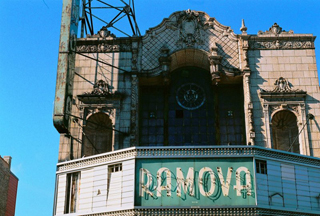Move Over Ramova, Time for a New Face
By Michele Lenni in Arts & Entertainment on Jan 6, 2011 9:30PM

Illustration by Michele Lenni, Chicagoist
In the decades that followed the once beautiful and ornate faux-marble and gilded plasterwork, the deep blue ceilings adorned with thousands of stars began to fall into disrepair. Ramova moved from showing first-run cinematic greats to second run movies and finally settling on Spanish-language films, as the Irish and Lithuanians that called Bridgeport home moved out. Once the '80s hit the theater closed entirely and has sat vacant ever since, becoming more of a blemish on the street than a shining focal point.
This is the story for many of Chicago's once eminent theaters; most of which have sat quietly vacant while stories of real estate buys, renovation and a return to their heyday swirl among developers, city officials and neighbors alike. Such is the story for the Ramova theater.
Maureen Sullivan is one of the proud and few proponents of the theater's return to its former glory. Sullivan launched the Save the Ramova campaign in 2006 and has collected 5,000 signatures of people who want to see the Ramova restored. In fact, Bridgeport blog, The Hardscrabbler claims this compares that to roughly 11,000 voters who cast ballots in the 11th ward in this year’s mid-term elections. 
Photo via metroblossom
Part of the battle begins in the tax-payers' pocket books. Being that the Ramova is larger venue than its sister theater, The Music Box, $10 a ticket is hardly enough to cover 15-years of water damage that has ensued since the theater's demise. It's obvious it is going to take additional compensation from the community in order to make the Ramova as beautiful and enticing to the Red Box and Netflix movie watchers as it was back in its heyday.
In order to realize her goal and get more comprehensive information as to whether the theater is a just structural and financial venture, Sullivan has added a new ally to her corner. According to Hardscrabbler, she convinced architect Rob Vagnieres to produce, on a pro-bono basis, schematic drawings that show a more varied mix of revenue streams. Her goal being something similar to the Beverly Arts Center, or the Portage Theater, which is home base for the Silent Film Society of Chicago, but also hosts a wide variety of events and supplements ticket revenues with beer and wine sales. Sullivan also enlisted the company that did the original ornamental plasterwork, and which is still in business a few blocks away.

image via pbase.com
To learn more about the Ramova and the fight to restore it go to Maureen Sullivan's Save The Ramova Facebook page or call Alderman James A. Balcer to give a voice to the now silent structure.